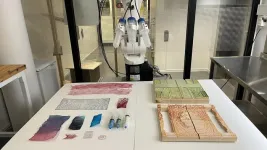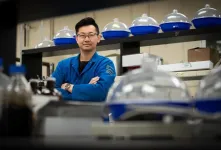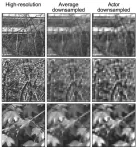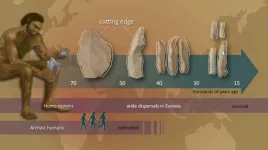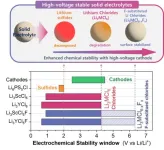(Press-News.org) For the first time, a hydrogel material made of nanocellulose and algae has been tested as an alternative, greener architectural material. The study, from Chalmers University of Technology in Sweden and the Wallenberg Wood Science Center, shows how the abundant sustainable material can be 3D printed into a wide array of architectural components, using much less energy than conventional construction methods.
The construction industry today consumes 50 percent of the world’s fossil resources, generates 40 percent of global waste and causes 39 percent of global carbon dioxide emissions. There is a growing line of research into biomaterials and their applications, in order to transition to a greener future in line with, for example, the European Green Deal.
Nanocellulose is not a new biomaterial, and its properties as a hydrogel are known within the field of biomedicine, where it can be 3D printed into scaffolds for tissue and cell growth, due to its biocompatibility and wetness. But it has never been dried and used as an architectural material before.
“For the first time we have explored an architectural application of nanocellulose hydrogel. Specifically, we provided the so far missing knowledge on its design-related features, and showcased, with the help of our samples and prototypes, the tuneability of these features through custom digital design and robotic 3D printing,” says Malgorzata Zboinska, lead author of the study from Chalmers University of Technology.
The team used nanocellulose fibres and water, with the addition of an algae-based material called alginate. The alginate allowed the researchers to produce a 3D printable material, since the alginate added an extra flexibility to the material when it dried.
Cellulose is coined as the most abundant eco-friendly alternative to plastic, as it is one of the byproducts of the world’s largest industries. “The nanocellulose used in this study can be acquired from forestry, agriculture, paper mills and straw residues from agriculture. It is a very abundant material in that sense,” says Malgorzata Zboinska.
3D printing and nanocellulose/ A resource efficient technique
The architectural industry is today surrounded by access to digital technologies which allows for a wider range of new techniques to be used, but there is a gap in the knowledge of how these techniques can be applied. According to the European Green Deal, as of 2030, buildings in Europe must be more resource-efficient, and this can be achieved through elevated reuse and recycling of materials, such as with nanocellulose, an upcycled, byproduct from industry. At the same time as buildings are to become more circular, cutting-edge digital techniques are highlighted as important leverages for achieving these goals.
“3D printing is a very resource efficient technique. It allows us to make products without other things such as dies and casting forms, so there is less waste material. It is also very energy efficient. The robotic 3D printing system we employ does not use heat, just air pressure. This saves a lot of energy as we are only working at room temperature,” says Malgorzata Zboinska.
The energy efficient process relies on the shear thinning properties of the nanocellulose hydrogel. When you apply pressure it liquifies allowing it to be 3D printed, but when you take away the pressure it maintains its shape. This allows the researchers to work without the energy intensive processes that are commonplace in the construction industry.
Malgorzata Zboinska and her team designed many different toolpaths to be used in the robotic 3D printing process to see how the nanocellulose hydrogel would behave when it dried in different shapes and patterns. These dried shapes could then be applied as a basis to design a wide array of architectural standalone components, such as lightweight room dividers, blinds, and wall panel systems. They could also form the basis for coatings of existing building components, such as tiles to clad walls, acoustic elements for damping sound, and combined with other materials to clad skeleton walls.
The future of greener building materials
“Traditional building materials are designed to last for hundreds of years. Usually, they have predictable behaviours and homogenous properties. We have concrete, glass and all kinds of hard materials that endure and we know how they will age over time. Contrary to this, biobased materials contain organic matter, that is from the outset designed to biodegrade and cycle back into nature. We, therefore, need to acquire completely new knowledge on how we could apply them in architecture, and how we could embrace their shorter life cycle loops and heterogenous behaviour patterns, resembling more those found in nature rather than in an artificial and fully controlled environment. Design researchers and architects are now intensely searching for ways of designing products made from these materials, both for function and for aesthetics,” says Malgorzata Zboinska.
This study provides the first steps to demonstrate the upscaling potentials of ambient-dried, 3D-printed nanocellulose membrane constructs, as well as a new understanding of the relationship between the design of the material’s deposition pathways via 3D printing, and the dimensional, textural, and geometric effects in the final constructs. This knowledge is a necessary stepping stone that will allow Malgorzata Zboinska and her team to develop, through further research, applications of nanocellulose in architectural products that need to meet specific functional and aesthetic user requirements.
“The yet not fully known properties of novel biobased materials prompt architectural researchers to establish alternative approaches to designing these new products, not only in terms of the functional qualities, but also the acceptance from the users. The aesthetics of biobased materials are an important part of this. If we are to propose these biobased materials to society and people, we need to work with the design as well. This becomes a very strong element for the acceptance of these materials. If people do not accept them, we will not reach the goals of a circular economy and sustainable built environment”.
More about the research:
The research is presented in a paper: "Robotically 3D printed architectural membranes from ambient dried cellulose nanofibril-alginate hydrogel", published in the journal Materials and Design.
The researchers involved in the study are Malgorzata A. Zboinska, Sanna Sämfors and Paul Gatenholm. The researchers were active at Chalmers University of Technology and the Wallenberg Wood Science Center, both in Sweden, at the time of the study.
This work was supported by Adlerbertska Research Foundation and Chalmers University of Technology’s Area of Advance Materials Science. The Knut and Alice Wallenberg Foundation is gratefully acknowledged for funding the Wallenberg Wood Science Center. The authors would also like to recognise the contribution of Karl Åhlund, who assisted in the robotic extrusion system development.
Fact box – previous research:
Printing with nanocellulose was first developed at Chalmers University of Technology within the Wallenberg Wood Science Center in 2015. This is the first time this technology is being scaled up towards applications in buildings.
For more information, please contact:
Malgorzata A. Zboinska, Associate Professor, Department of Architecture and Civil Engineering, Chalmers University of Technology, Sweden, +46 31 772 65 27, malgorzata.zboinska@chalmers.se
The contact person Malgorzata speaks English, Swedish and Polish and is available for live and pre-recorded interviews. At Chalmers, we have podcast studios and broadcast filming equipment on site and would be able to assist a request for a television, radio or podcast interview.
END
3D printed nanocellulose upscaled for green architectural applications
2024-02-07
ELSE PRESS RELEASES FROM THIS DATE:
Inexpensive, carbon-neutral biofuels are finally possible
2024-02-07
When it comes to making fuel from plants, the first step has always been the hardest — breaking down the plant matter. A new study finds that introducing a simple, renewable chemical to the pretreatment step can finally make next-generation biofuel production both cost-effective and carbon neutral.
For biofuels to compete with petroleum, biorefinery operations must be designed to better utilize lignin. Lignin is one of the main components of plant cell walls. It provides plants with greater structural integrity and resiliency from microbial attacks. However, these natural properties of lignin also make it difficult to extract and utilize ...
Will this new solar maximum solve the puzzle of the Sun’s gamma-ray picture?
2024-02-07
The Sun’s polar regions were the most active emitting high energy radiation during the previous solar maximum, an imbalance yet to be explained, and reported for the first time in a study led by a researcher of the Faculty of Sciences of the University of Lisbon (Ciências ULisboa) (Portugal).
The Sun shines brightly in the visible light, but how does it look like at the highest energies of the electromagnetic radiation? The Sun’s picture taken in gamma rays is a deadly sight, luckily blinded by the Earth’s atmosphere and only seen from space. Each photon carries a billion times more energy than its ultraviolet sibling. How does the Sun’s regular gamma rays’ ...
A machine learning framework that encodes images like a retina
2024-02-07
A major challenge to developing better neural prostheses is sensory encoding: transforming information captured from the environment by sensors into neural signals that can be interpreted by the nervous system. But because the number of electrodes in a prosthesis is limited, this environmental input must be reduced in some way, while still preserving the quality of the data that is transmitted to the brain.
Demetri Psaltis (Optics Lab) and Christophe Moser (Laboratory of Applied Photonics Devices) collaborated with Diego Ghezzi of the Hôpital ophtalmique Jules-Gonin – Fondation Asile des Aveugles (previously Medtronic Chair in Neuroengineering at EPFL) to apply machine ...
Innovation in stone tool technology involved multiple stages at the time of modern human dispersals
2024-02-07
A study led by researchers at the Nagoya University Museum in Japan may change how we understand the cultural evolution of Homo sapiens at the time of their dispersal across Eurasia about 50,000 to 40,000 years ago. These findings challenge traditional beliefs about the timing and nature of cultural transitions during this critical period in human history.
Published in Nature Communications, the researchers’ insights into stone tool technology suggest that the commonly held view of a ‘revolution’ in culture and technology that allowed anatomically modern humans to outcompete ...
New study sheds new light on forests' role in climate and water cycle
2024-02-07
Forests, which cover a third of Earth's land surface, are pivotal in carbon storage and the water cycle, though the full scope of their impact remains to be fully understood. In a new study published in Nature Communications, researchers from Stockholm University and international colleagues provide new insights into the complex role forests play in the climate system and water cycle.
The research, involving scientists from 11 institutions across five countries, including Sweden, the UK, Finland, Germany, and Brazil, highlights the intricate relationship between forests, particularly their emission ...
Repetitive high concentration capsaicin patch applications for nerve pain in a real-world setting
2024-02-07
Capsaicin, derived from hot chili pepper plants, has been used to treat various types of pain, and a high concentration capsaicin patch (HCCP) is approved for the treatment of nerve (or neuropathic) pain. In a real-world study published in Pain Practice that included 97 outpatients in Germany diagnosed primarily with neuropathic back pain, postoperative/posttraumatic neuropathic pain, or postherpetic neuralgia (shingles pain), patients appeared to benefit from multiple HCCP applications.
Among the ...
Does gender affect food allergy’s impact on quality of life?
2024-02-07
An analysis of relevant published studies indicates that across all ages, food allergy negatively affects individuals’ quality of life to a greater extent in females than in males.
The analysis, which is published in Clinical and Experimental Allergy, included 34 studies. In the studies, women and the parents of girls tended to report a greater impact of food allergy on health-related quality of life than men or parents of boys.
Evidence also showed that improvements in quality of life over the course of treatment for food allergy can be different for males and females, with weak evidence suggesting that male children may experience more improvements ...
Does air pollution contribute to global cardiovascular disease–related deaths?
2024-02-07
A recent analysis of data from nearly all World Health Organization member states clearly demonstrates a link between air pollution and mortality from cardiovascular diseases, with more of such deaths associated with air pollution in low-income countries compared with high-income countries.
In all 183 countries included in the Chronic Diseases and Translational Medicine study, ischemic heart disease-related deaths attributed to air pollution were higher than stroke-related deaths caused by air pollution. In 2019, outdoor air pollution caused 16 ischemic heart disease-related deaths per 100,000 people in high-income countries compared with 70 per 100,000 in low-income countries.
Also, in ...
Researchers develop and test the first unmanned forestry machine
2024-02-07
A study published in the Journal of Field Robotics assessed the world’s first unmanned machine designed for autonomous forestry operations. Investigators demonstrated that using computer vision, autonomous navigation, and manipulator control algorithms, their newly developed machine can safely, accurately, and efficiently pick up logs from the ground and maneuver through various forest terrains without the need for human intervention.
The research represents a significant milestone in the field of autonomous outdoor robotics, which could reduce the need for human labor, thereby increasing productivity and reducing labor costs, while ...
KIST-LLNL raises expectations for commercialization of high-energy-density all-solid-state batteries
2024-02-07
Researchers are actively working on non-flammable solid electrolytes as a safer alternative to liquid electrolytes commonly found in lithium-ion batteries, which are vulnerable to fires and explosions. While sulfide-based solid electrolytes exhibit excellent ionic conductivity, their chemical instability with high-voltage cathode materials necessary for high-energy-density batteries has impeded their commercial viability. Consequently, there has been a growing interest in chloride-based solid electrolytes, which are stability in high-voltage conditions due to their strong bonding ...
